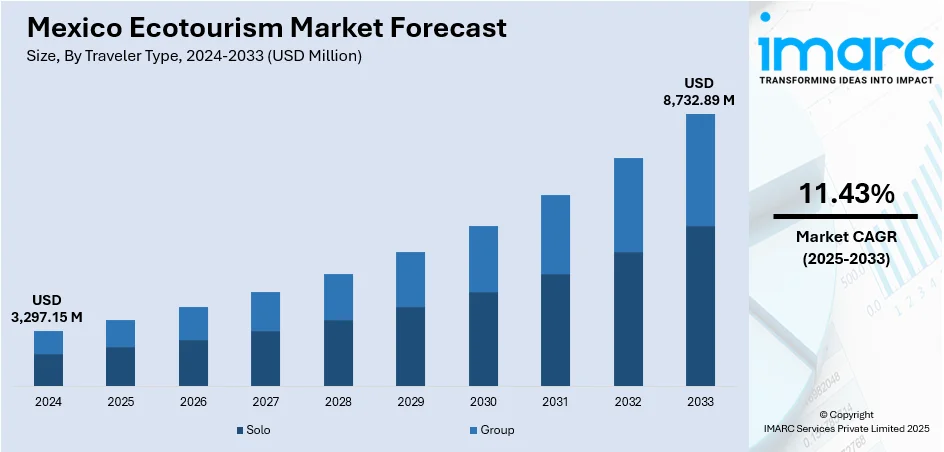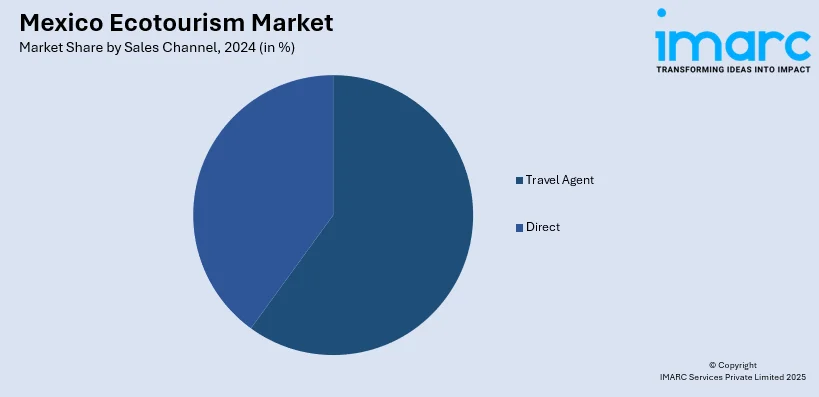
Mexico Ecotourism Market Size, Share, Trends and Forecast by Traveler Type, Age Group, Sales Channel, and Region, 2025-2033
Mexico Ecotourism Market Overview:
The Mexico ecotourism market size reached USD 3,297.15 Million in 2024. The market is projected to reach USD 8,732.89 Million by 2033, exhibiting a growth rate (CAGR) of 11.43% during 2025-2033. The market is fueled by the nation's high biodiversity, cultural heritage sites, and conservation efforts supported by the government initiatives. Further, high demand for green travel experiences has spurred investment in indigenous tourism ventures, nature reserves, and eco-lodges. Apart from this, expanding awareness of climate change and environment stewardship is even inducing domestic and international tourists to shift toward low-footprint, community-based ecotourism, which is also augmenting the Mexico ecotourism market share.
|
Report Attribute
|
Key Statistics
|
|---|---|
|
Base Year
|
2024 |
|
Forecast Years
|
2025-2033
|
|
Historical Years
|
2019-2024
|
| Market Size in 2024 | USD 3,297.15 Million |
| Market Forecast in 2033 | USD 8,732.89 Million |
| Market Growth Rate 2025-2033 | 11.43% |
Mexico Ecotourism Market Trends:
Rising Influx of Domestic and International Ecotourists
Mexico is experiencing a significant rise in both domestic and international travelers seeking ecotourism experiences, fueled by growing global interest in sustainable travel and the country's extraordinary ecological diversity. With over 40 Million tourists visiting annually, and 45.04 Million international arrivals recorded in 2024 alone, destinations such as Chiapas, Oaxaca, Quintana Roo, and Baja California are witnessing a notable uptick in nature-focused tourism. These regions offer a wide range of eco-activities, from jungle treks and birdwatching to marine conservation excursions and visits to protected biosphere reserves. Moreover, iconic sites like the Sian Ka'an and Monarch Butterfly Biosphere Reserves continue to draw eco-conscious visitors from North America and Europe, attracted by the promise of cultural richness and biodiversity. In response to this growing demand, the private sector is expanding its offerings, including eco-lodges, certified sustainable resorts, and low-impact tour services. As travelers increasingly prioritize authenticity and environmental responsibility, ecotourism is emerging as one of the most dynamic and rapidly expanding segments of Mexico's tourism industry.

To get more information on this market, Request Sample
Expansion and Modernization of Ecotourism Infrastructure
Infrastructure development tailored to sustainable tourism is emerging as a pivotal factor propelling the Mexico ecotourism market growth. Investments are increasingly directed toward improving access to remote natural areas, enhancing visitor facilities, and implementing eco-friendly transport solutions. Moreover, projects such as improved signage and trails in biosphere reserves, solar-powered eco-lodges, and wastewater treatment systems are implemented in priority destinations. Notably, the government's support for intermodal transport connectivity, such as electric buses in urban ecotourism hubs and improved roads in mountainous and coastal regions, is facilitating safer and more sustainable travel. For instance, on September 20, 2024, Taruk, Mexico's first fully domestically designed and manufactured electric bus, was introduced in Mexico City, developed by a collaboration of CONAHCYT, Dina, Megaflux, and UNAM. The bus accommodates approximately 60–69 passengers, delivers up to 200–300 km on a single four‑hour charge, and is built with 70% locally sourced components. Initially deployed on Route 46 in CDMX, production capacity is projected at 3,000–4,000 units annually, positioning the initiative as a milestone in Mexico's pursuit of industrial sovereignty in electromobility. Apart from this, public-private partnerships are also on the rise, with NGOs and tourism developers collaborating on visitor centers, wildlife observation towers, and low-impact camping sites. These developments reflect a growing recognition that quality infrastructure is essential not only for tourist satisfaction but also for minimizing environmental degradation and ensuring long-term destination viability.
Mexico Ecotourism Market Segmentation:
IMARC Group provides an analysis of the key trends in each segment of the market, along with forecasts at the country and regional levels for 2025-2033. Our report has categorized the market based on traveler type, age group, and sales channel.
Traveler Type Insights:
- Solo
- Group
The report has provided a detailed breakup and analysis of the market based on the traveler type. This includes solo and group.
Age Group Insights:
- Generation X
- Generation Y
- Generation Z
A detailed breakup and analysis of the market based on the age group have also been provided in the report. This includes generation X, generation Y, and generation Z.
Sales Channel Insights:

- Travel Agent
- Direct
The report has provided a detailed breakup and analysis of the market based on the sales channel. This includes travel agent and direct.
Regional Insights:
- Northern Mexico
- Central Mexico
- Southern Mexico
- Others
The report has also provided a comprehensive analysis of all the major regional markets, which include Northern Mexico, Central Mexico, Southern Mexico, and others.
Competitive Landscape:
The market research report has also provided a comprehensive analysis of the competitive landscape. Competitive analysis such as market structure, key player positioning, top winning strategies, competitive dashboard, and company evaluation quadrant has been covered in the report. Also, detailed profiles of all major companies have been provided.
Mexico Ecotourism Market News:
- On June 12, 2024, Mexico’s Ministry of Tourism (SECTUR) officially launched the Strategy for Sustainable Ocean‑Based Tourism Activities, a collaborative initiative aimed at fostering economic growth in coastal communities while safeguarding their natural and cultural assets. Developed through a joint effort by SECTUR, the Ministry of Foreign Affairs, and international partners, the strategy builds upon Mexico’s 2021 sustainable ocean economy framework and aligns with its commitments under the UN Ocean Panel.
- On March 27, 2025, UNESCO and Dior launched a collaborative conservation and sustainable development initiative to support community enterprises and ecotourism around Mexico's Monarch Butterfly Biosphere Reserve, a UNESCO-designated site home to millions of migrating monarch butterflies. The project benefits over 60 local producers by strengthening five microenterprises in the Monarch Butterfly Collective Brand, offering training in business development, marketing, and access to new markets. Additionally, the initiative includes updating educational signage at key butterfly sanctuaries to enhance visitor engagement and awareness of the reserve's ecological importance.
Mexico Ecotourism Market Report Coverage:
| Report Features | Details |
|---|---|
| Base Year of the Analysis | 2024 |
| Historical Period | 2019-2024 |
| Forecast Period | 2025-2033 |
| Units | Million USD |
| Scope of the Report |
Exploration of Historical Trends and Market Outlook, Industry Catalysts and Challenges, Segment-Wise Historical and Future Market Assessment:
|
| Traveler Types Covered | Solo, Group |
| Age Groups Covered | Generation X, Generation Y, Generation Z |
| Sales Channels Covered | Travel Agent, Direct |
| Regions Covered | Northern Mexico, Central Mexico, Southern Mexico, Others |
| Customization Scope | 10% Free Customization |
| Post-Sale Analyst Support | 10-12 Weeks |
| Delivery Format | PDF and Excel through Email (We can also provide the editable version of the report in PPT/Word format on special request) |
Key Questions Answered in This Report:
- How has the Mexico ecotourism market performed so far and how will it perform in the coming years?
- What is the breakup of the Mexico ecotourism market on the basis of traveler type?
- What is the breakup of the Mexico ecotourism market on the basis of age group?
- What is the breakup of the Mexico ecotourism market on the basis of sales channel?
- What is the breakup of the Mexico ecotourism market on the basis of region?
- What are the various stages in the value chain of the Mexico ecotourism market?
- What are the key driving factors and challenges in the Mexico ecotourism market?
- What is the structure of the Mexico ecotourism market and who are the key players?
- What is the degree of competition in the Mexico ecotourism market?
Key Benefits for Stakeholders:
- IMARC’s industry report offers a comprehensive quantitative analysis of various market segments, historical and current market trends, market forecasts, and dynamics of the Mexico ecotourism market from 2019-2033.
- The research report provides the latest information on the market drivers, challenges, and opportunities in the Mexico ecotourism market.
- Porter's five forces analysis assist stakeholders in assessing the impact of new entrants, competitive rivalry, supplier power, buyer power, and the threat of substitution. It helps stakeholders to analyze the level of competition within the Mexico ecotourism industry and its attractiveness.
- Competitive landscape allows stakeholders to understand their competitive environment and provides an insight into the current positions of key players in the market.
Need more help?
- Speak to our experienced analysts for insights on the current market scenarios.
- Include additional segments and countries to customize the report as per your requirement.
- Gain an unparalleled competitive advantage in your domain by understanding how to utilize the report and positively impacting your operations and revenue.
- For further assistance, please connect with our analysts.
 Request Customization
Request Customization
 Speak to an Analyst
Speak to an Analyst
 Request Brochure
Request Brochure
 Inquire Before Buying
Inquire Before Buying




.webp)




.webp)












